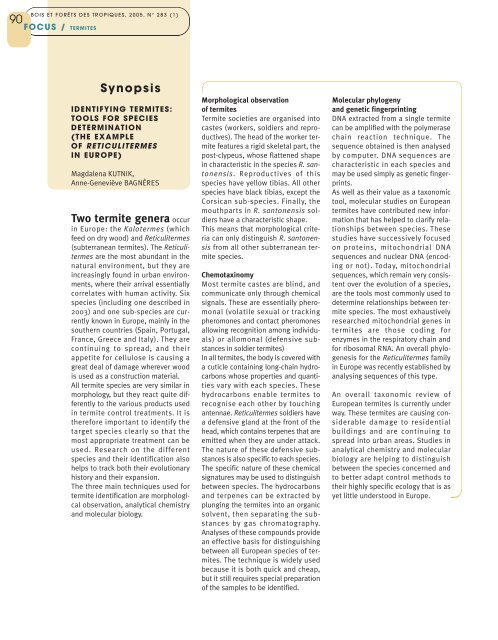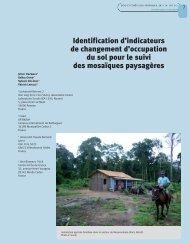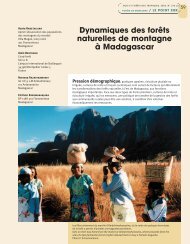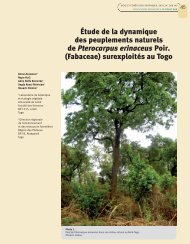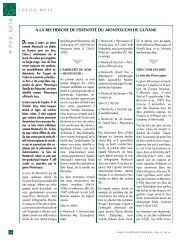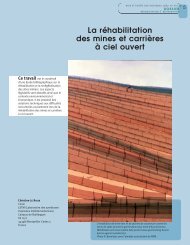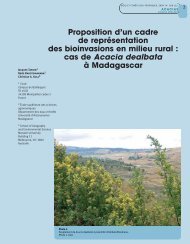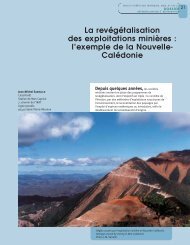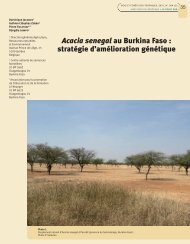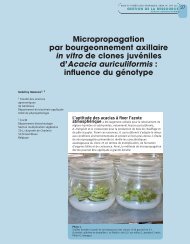outils de détermination des espèces - Bois et forêts des tropiques
outils de détermination des espèces - Bois et forêts des tropiques
outils de détermination des espèces - Bois et forêts des tropiques
- No tags were found...
Create successful ePaper yourself
Turn your PDF publications into a flip-book with our unique Google optimized e-Paper software.
90BOIS ET FORÊTS DES TROPIQUES, 2005, N° 283 (1)FOCUS / TERMITESSynopsisIDENTIFYING TERMITES:TOOLS FOR SPECIESDETERMINATION(THE EXAMPLEOF RETICULITERMESIN EUROPE)Magdalena KUTNIK,Anne-Geneviève BAGNÈRESTwo termite genera occurin Europe: the Kalotermes (whichfeed on dry wood) and R<strong>et</strong>iculitermes(subterranean termites). The R<strong>et</strong>iculitermesare the most abundant in thenatural environment, but they areincreasingly found in urban environments,where their arrival essentiallycorrelates with human activity. Sixspecies (including one <strong>de</strong>scribed in2003) and one sub-species are currentlyknown in Europe, mainly in thesouthern countries (Spain, Portugal,France, Greece and Italy). They arecontinuing to spread, and theirapp<strong>et</strong>ite for cellulose is causing agreat <strong>de</strong>al of damage wherever woodis used as a construction material.All termite species are very similar inmorphology, but they react quite differentlyto the various products usedin termite control treatments. It istherefore important to i<strong>de</strong>ntify th<strong>et</strong>arg<strong>et</strong> species clearly so that themost appropriate treatment can beused. Research on the differentspecies and their i<strong>de</strong>ntification alsohelps to track both their evolutionaryhistory and their expansion.The three main techniques used fortermite i<strong>de</strong>ntification are morphologicalobservation, analytical chemistryand molecular biology.Morphological observationof termitesTermite soci<strong>et</strong>ies are organised intocastes (workers, soldiers and reproductives).The head of the worker termitefeatures a rigid skel<strong>et</strong>al part, thepost-clypeus, whose flattened shapein characteristic in the species R. santonensis.Reproductives of thisspecies have yellow tibias. All otherspecies have black tibias, except theCorsican sub-species. Finally, themouthparts in R. santonensis soldiershave a characteristic shape.This means that morphological criteriacan only distinguish R. santonensisfrom all other subterranean termitespecies.ChemotaxinomyMost termite castes are blind, andcommunicate only through chemicalsignals. These are essentially pheromonal(volatile sexual or trackingpheromones and contact pheromonesallowing recognition among individuals)or allomonal (<strong>de</strong>fensive substancesin soldier termites)In all termites, the body is covered witha cuticle containing long-chain hydrocarbonswhose properties and quantitiesvary with each species. Thesehydrocarbons enable termites torecognise each other by touchingantennae. R<strong>et</strong>iculitermes soldiers havea <strong>de</strong>fensive gland at the front of thehead, which contains terpenes that areemitted when they are un<strong>de</strong>r attack.The nature of these <strong>de</strong>fensive substancesis also specific to each species.The specific nature of these chemicalsignatures may be used to distinguishb<strong>et</strong>ween species. The hydrocarbonsand terpenes can be extracted byplunging the termites into an organicsolvent, then separating the substancesby gas chromatography.Analyses of these compounds provi<strong>de</strong>an effective basis for distinguishingb<strong>et</strong>ween all European species of termites.The technique is wi<strong>de</strong>ly usedbecause it is both quick and cheap,but it still requires special preparationof the samples to be i<strong>de</strong>ntified.Molecular phylogenyand gen<strong>et</strong>ic fingerprintingDNA extracted from a single termitecan be amplified with the polymerasechain reaction technique. Thesequence obtained is then analysedby computer. DNA sequences arecharacteristic in each species andmay be used simply as gen<strong>et</strong>ic fingerprints.As well as their value as a taxonomictool, molecular studies on Europeantermites have contributed new informationthat has helped to clarify relationshipsb<strong>et</strong>ween species. Thesestudies have successively focusedon proteins, mitochondrial DNAsequences and nuclear DNA (encodingor not). Today, mitochondrialsequences, which remain very consistentover the evolution of a species,are the tools most commonly used to<strong>de</strong>termine relationships b<strong>et</strong>ween termitespecies. The most exhaustivelyresearched mitochondrial genes intermites are those coding forenzymes in the respiratory chain andfor ribosomal RNA. An overall phylogenesisfor the R<strong>et</strong>iculitermes familyin Europe was recently established byanalysing sequences of this type.An overall taxonomic review ofEuropean termites is currently un<strong>de</strong>rway. These termites are causing consi<strong>de</strong>rabledamage to resi<strong>de</strong>ntialbuildings and are continuing tospread into urban areas. Studies inanalytical chemistry and molecularbiology are helping to distinguishb<strong>et</strong>ween the species concerned andto b<strong>et</strong>ter adapt control m<strong>et</strong>hods totheir highly specific ecology that is asy<strong>et</strong> little un<strong>de</strong>rstood in Europe.


